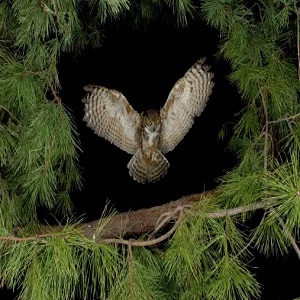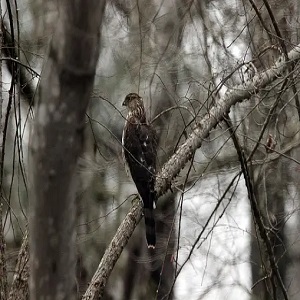Introduction: The Stealthy Birds
Stealthy birds are those that have evolved adaptations to help them avoid detection by their prey, predators, or mates. These adaptations can include camouflage, quiet flight, and other features that help the bird blend in with its surroundings or move silently.

Some of the most stealthy birds include owls, nightjars, and hoatzins. Owls have feathers that are designed to break up their outline and make them difficult to see, as well as large eyes that help them see in the dark. Nightjars have cryptic plumage that helps them blend in with their surroundings, and they also fly with slow, fluttering wingbeats that make little noise. Hoatzins have soft, downy feathers that help them blend in with the vegetation in the rainforest, and they also have a strange call that is thought to confuse predators.
Stealthy birds play an important role in the ecosystem. Owls, for example, are important predators of small mammals, and nightjars help to control insect populations. Hoatzins are also important in the rainforest, as their droppings help to fertilize the soil.
The next time you are out in nature, take a closer look at the birds around you. You may be surprised at how many of them have evolved adaptations for stealth.
Here are some additional facts about stealthy birds:
- The owl is the most well-known stealthy bird. It has soft feathers that help it to fly silently, and its large eyes give it excellent night vision.
- The nightjar is another stealthy bird that is found in many parts of the world. It has cryptic plumage that helps it to blend in with its surroundings, and it flies with slow, fluttering wingbeats that make little noise.
- The hoatzin is a strange-looking bird that is found in the rainforests of South America. It has soft, downy feathers that help it to blend in with the vegetation, and it has a strange call that is thought to confuse predators.
Stealthy birds are fascinating creatures that have adapted to their environment in amazing ways. They play an important role in the ecosystem, and they continue to amaze us with their stealth and agility.
Adaptations for Stealth:
Here are some of the adaptations that stealthy birds have evolved to help them avoid detection:
- Camouflage: Many stealthy birds have evolved to blend in with their surroundings. This can be done through a variety of methods, such as having feathers that match the color of the leaves or bark of trees, or having patterns on their feathers that break up their outline.
- Quiet flight: Stealthy birds often have features that help them fly quietly, such as broad wings that create less turbulence, or feathers that are soft and downy. This allows them to approach their prey or avoid predators without being heard.
- Other adaptations: Some stealthy birds have other adaptations that help them avoid detection, such as the ability to see in low light or to fly very slowly.

Here are some specific examples of stealthy birds and their adaptations:
- The owl: Owls are perhaps the most well-known stealthy birds. They have large, forward-facing eyes that give them excellent night vision, and their feathers are soft and downy, which helps them fly quietly.
- The kingfisher: Kingfishers are birds of prey that live near water. They have brightly colored plumage that helps them blend in with the rocks and vegetation near rivers and streams. They also have a long, pointed bill that helps them spear fish without making a splash.
- The woodcock: Woodcocks are found in forests and woodlands. They have mottled brown plumage that helps them blend in with the leaf litter on the forest floor. They also have a long, flexible bill that they use to probe for worms and other small animals.
- The nightjar: Nightjars are nocturnal birds that are found in many parts of the world. They have cryptic plumage that helps them blend in with their surroundings at night. They also have a rapid wingbeat that creates a humming sound, which helps to camouflage them from predators.
These are just a few examples of the many stealthy birds that exist. These birds have evolved a variety of adaptations to help them avoid detection, which allows them to survive and thrive in a variety of habitats.
What Temperature Is Too Hot For Birds? A Guide Of 20 Tips To Safe Temperatures
Benefits of Stealth
The benefits of stealth for birds are many and varied. Stealth can help birds to:
- Hunt successfully: Many stealthy birds are predators, and they use their stealth to sneak up on their prey. For example, the owl has a soft, silent flight that allows it to approach its prey undetected.
- Avoid predators: Stealth can also help birds to avoid being preyed upon themselves. For example, the woodcock has cryptic coloration that helps it to blend in with its surroundings, making it difficult for predators to see.
- Mate successfully: Stealth can also be an advantage in attracting mates. For example, the male bowerbird builds a elaborately decorated bower to attract females, and he is more likely to be successful if he can do so without being seen by other males.
- Nest and raise young: Stealth can also be important for birds when they are nesting and raising young. For example, the nightjar lays its eggs on the ground, and its cryptic coloration helps to camouflage them from predators.

In addition to these specific benefits, stealth can also give birds a general advantage in the struggle for survival. By being able to move about undetected, birds are less likely to be caught by predators or to have their food stolen. This can give them a better chance of surviving and reproducing.
Here are some specific examples of how stealth benefits different types of birds:
- Owls are nocturnal predators that use their stealth to hunt small mammals such as mice and voles. Their soft, silent flight allows them to approach their prey undetected.
- Woodcocks are shorebirds that have cryptic coloration that helps them to blend in with the ground. This camouflage makes them difficult for predators to see, both when they are standing still and when they are flying.
- Bowerbirds are Australian birds that build elaborately decorated bowers to attract mates. The males of some species of bowerbirds are more likely to be successful at attracting mates if they can do so without being seen by other males.
- Nightjars are nocturnal birds that lay their eggs on the ground. Their cryptic coloration helps to camouflage the eggs from predators.
These are just a few examples of how stealth benefits birds. Stealth is a valuable adaptation that has helped birds to survive and thrive in a variety of habitats.
The Evolution of Stealthy Birds
The evolution of stealthy birds is a complex process that has been driven by a variety of factors, including the need to hunt prey, avoid predators, and attract mates.
One of the most important factors in the evolution of stealth is the development of camouflage. Camouflage helps birds to blend in with their surroundings, making them difficult for predators to see. There are many different types of camouflage, including cryptic coloration, which matches the bird’s surroundings, and disruptive coloration, which breaks up the bird’s outline.

Another important factor in the evolution of stealth is the development of quiet flight. Quiet flight allows birds to approach their prey undetected. There are a number of features that contribute to quiet flight, including the shape of the wings, the way the feathers are arranged, and the way the bird flaps its wings.
In addition to camouflage and quiet flight, there are a number of other adaptations that have helped birds to become stealthy. These include:
- Behavioral adaptations: Some birds, such as owls, are nocturnal, which helps them to avoid predators and hunt prey. Other birds, such as woodcocks, have cryptic coloration that helps them to blend in with the ground when they are standing still.
- Physical adaptations: Some birds, such as nightjars, have feathers that are adapted to absorb sound, making their flight quieter. Other birds, such as hawks, have sharp talons and beaks that help them to catch and kill prey.
The evolution of stealthy birds is an ongoing process. As birds continue to adapt to their environment, we can expect to see even more amazing examples of stealth in the future.
The Biology of Stealthy Birds
The biology of stealthy birds is a fascinating topic that has been studied by scientists for many years. There are a number of different biological adaptations that help birds to be stealthy, including:
- Camouflage: Camouflage is one of the most important adaptations for stealth. It helps birds to blend in with their surroundings, making them difficult for predators to see. There are many different types of camouflage, including cryptic coloration, which matches the bird’s surroundings, and disruptive coloration, which breaks up the bird’s outline.
- Quiet flight: Quiet flight is another important adaptation for stealth. It allows birds to approach their prey undetected. There are a number of features that contribute to quiet flight, including the shape of the wings, the way the feathers are arranged, and the way the bird flaps its wings.
- Behavioral adaptations: Some birds have behavioral adaptations that help them to be stealthy. For example, owls are nocturnal, which helps them to avoid predators and hunt prey. Other birds, such as woodcocks, have cryptic coloration that helps them to blend in with the ground when they are standing still.
- Physical adaptations: Some birds have physical adaptations that help them to be stealthy. For example, nightjars have feathers that are adapted to absorb sound, making their flight quieter. Other birds, such as hawks, have sharp talons and beaks that help them to catch and kill prey.
The biology of stealthy birds is a complex and fascinating topic. By understanding these adaptations, we can learn more about how birds survive and thrive in the wild.
The Behavior of Stealthy Birds

The behavior of stealthy birds is also adapted to their need to be undetected. Some of the common behaviors of stealthy birds include:
- Moving slowly and quietly: Stealthy birds often move slowly and quietly to avoid making noise. This can be seen in owls, which often fly with their wings held close to their bodies to reduce noise.
- Hiding in vegetation: Stealthy birds often hide in vegetation to camouflage themselves. This can be seen in woodcocks, which often rest on the ground in tall grass or weeds.
- Using camouflage: Stealthy birds often have camouflaged plumage that helps them to blend in with their surroundings. This can be seen in nightjars, which have mottled brown and gray feathers that help them to blend in with the forest floor.
- Being nocturnal: Some stealthy birds are nocturnal, which means that they are active at night. This helps them to avoid predators and to hunt prey that is also active at night.
- Using other senses: Stealthy birds often rely on their other senses, such as hearing and smell, to help them to find food and avoid predators. This can be seen in owls, which have very acute hearing that helps them to locate prey in the dark.
The behavior of stealthy birds is a complex and fascinating topic. By understanding these behaviors, we can learn more about how birds survive and thrive in the wild.
Hover Birds : An Important Guide To Unique Avian Flight [2023]
The Importance of Stealth for Birds
Stealth is essential for many birds, as it allows them to avoid predators, capture prey, and even attract mates. Here are some of the reasons why stealth is important for birds:
- To avoid predators: Many birds are preyed upon by other animals, such as hawks, owls, and snakes. Stealth can help these birds to avoid detection by predators by making them difficult to see or hear. For example, the owlet nightjar has cryptic coloration that helps it to blend in with its surroundings, making it difficult for predators to see. The barn owl has silent flight, which allows it to sneak up on its prey without being heard.
- To capture prey: Some birds, such as hawks and owls, are predators that use stealth to catch their prey. By flying silently and unseen, these birds can surprise their prey and catch them off guard. For example, the owl has excellent night vision, which allows it to see its prey in the dark. The hawk has sharp talons and beak, which it uses to kill its prey.
- To attract mates: Some birds use stealth to attract mates. For example, the male woodcock makes a loud drumming sound to attract females. The male bowerbird builds a complex nest to attract females.
Stealth is just one of the many adaptations that birds have evolved to survive and thrive in their environment. By being stealthy, birds can increase their chances of survival and reproduction.
Here are some other examples of stealthy birds:
- The kingfisher: The kingfisher is a bird of prey that lives near water. It has a long, pointed beak and a dagger-like tongue. The kingfisher uses stealth to catch its prey, such as fish and frogs.
- The hummingbird: The hummingbird is a small bird that is known for its ability to fly quickly and hover. It uses stealth to catch its prey, such as insects and nectar.
- The owl: The owl is a nocturnal bird of prey that has excellent night vision. It uses stealth to catch its prey, such as mice and voles.
- The snakebird: The snakebird is a bird that lives in swamps and marshes. It has a long, slender neck and a sharp beak. The snakebird uses stealth to catch its prey, such as snakes and fish.
These are just a few examples of the many stealthy birds that exist. Stealth is an important adaptation that helps these birds to survive and thrive in their environment.
Conclusion
Stealthy birds are facing a number of threats, including:
- Habitat loss: Stealthy birds often live in specific habitats, such as forests or wetlands. The destruction of these habitats can make it difficult for these birds to find food and shelter.
- Pollution: Pollution can harm stealthy birds in a number of ways. It can contaminate their food and water, and it can also damage their feathers and make it difficult for them to fly.
- Climate change: Climate change is causing changes in the environment that can make it difficult for stealthy birds to survive. For example, climate change is causing some habitats to become drier, which can make it difficult for birds to find food and water.
- Hunting: Stealthy birds are often hunted for their feathers, meat, or eggs.
Collisions with buildings: Stealthy birds often fly at night, which can make them more likely to collide with buildings. This can be a major source of mortality for these birds.
There are a number of things that can be done to conserve stealthy birds, including:
- Protecting their habitats: Stealthy birds need their habitats to survive. We can protect these habitats by creating protected areas, such as national parks and wildlife refuges.
- Reduce pollution: We can reduce pollution by reducing our emissions of greenhouse gases and other pollutants. This will help to improve the quality of the air and water that stealthy birds need to survive.
- Educating the public: We can educate the public about the threats facing stealthy birds and how they can help to conserve them. This can be done through school programs, public awareness campaigns, and other initiatives.
- Supporting conservation organizations: There are a number of conservation organizations that are working to protect stealthy birds. We can support these organizations by donating money, volunteering our time, or spreading the word about their work.
FAQs:
What are some examples of stealthy birds?
Some examples of stealthy birds include owls, hawks, kingfishers, and nightjars. These birds have evolved a variety of adaptations that help them to avoid detection, such as camouflage, silent flight, and sharp vision.
Why are stealth adaptations important for birds?
Stealth adaptations are important for birds for a variety of reasons. For example, they can help birds to avoid predators, capture prey, and build nests.
How do stealthy birds camouflage themselves?
Stealthy birds camouflage themselves in a variety of ways. Some birds, such as owls, have feathers that are the same color as their surroundings. Other birds, such as kingfishers, have disruptive patterns on their feathers that break up their outline.
How do stealthy birds fly silently?
Stealthy birds fly silently by using soft feathers that reduce air turbulence. They also flap their wings slowly and smoothly.
What are some other fascinating adaptations of stealthy birds?
Some other fascinating adaptations of stealthy birds include their keen vision, their sharp hearing, and their ability to blend in with their surroundings.

